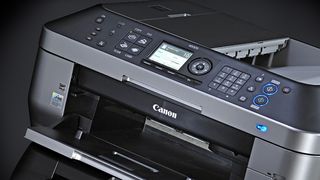Choosing a printer for your business
Laser, multifunction, inkjet or workgroup, which is best?

Most office work these days is carried out electronically, without the need for piles of paper that need to be stored in space-hungry filing cabinets, or disposed of with environmental sensitivity.
So is the office printer obsolete? Well, no, not yet. We all need printers from time to time. If you visited 100 businesses, you'd be lucky to find one that didn't have a printer tucked away somewhere, perhaps for knocking out marketing materials or outputting hard copy letters to customers.
If having a printer is still a necessity, which type is best for your business? Let's consider the main categories:
Trusty lasers
A laser printer is the favoured workhorse of most businesses, great at printing a high volume of crisp, clean-looking documents quickly.
Laser printers are good value for money, especially if used regularly over a period of time. If you roll together the cost of buying the unit, maintaining it and keeping it supplied with toner ink, then it will generally represent a much lower price per page than other types of printer.
Care needs to be taken when making the initial laser printer buying decision. Basic models will print only black and white – which may be exactly what you are after. You will need to near enough double your capital outlay to buy a colour laser, which will naturally also add to the cost of consumables.
Monochrome or colour laser?
Whether choosing monochrome or colour, it is generally a false economy to buy the cheapest laser you can. If you are expecting to produce a middling to high volume of printed materials on a daily basis, you want a solidly built machine that has the potential go on for years without giving you trouble. A £40 bargain basement job might pass muster as an occasionally used home model, but for a decent office-class mono laser you can expect to pay a lot more than that. How much more depends on a range of factors.
Get daily insight, inspiration and deals in your inbox
Get the hottest deals available in your inbox plus news, reviews, opinion, analysis and more from the TechRadar team.
A good laser might cost more than other types of printer up front, but the payback is that a laser toner cartridge will last a lot longer than the cartridges that inkjets burn through so fast. One toner cartridge should produce at least a thousand mono pages before it needs replacing.
The workgroup printer - a laser for sharing
There may be other reasons not to go for the cheapest laser besides solidity of build. If you want one printer that serves multiple people around the office, then look for a workgroup model that will by design be bigger and stronger than a personal printer that sits by one user's desk. A workgroup model will sit happily at the centre of a wired or wireless local area network, shared by a dozen or more people.
Think about paper supply too. In an office where several people will be printing, you want a paper tray that handles 250 sheets or more, or perhaps two paper trays, one for A4 and one for A3 or some other size. And the more memory your printer has, the larger and more complex the documents it can handle easily. A laser used for non-graphical documents should be up to managing 15 to 30 pages per minute.
Once you have all these capabilities on board, you may be looking at a price tag of £1,000 or so.
Cheap and cheerful inkjets
Inkjets are ideal if you want to print high-quality, colour graphics or photos on an occasional basis. If your colour printing requirements are in any way on the heavy side, then be prepared for the consequently high cost of replacement ink cartridges. Inkjets are slower than lasers too, so less suited for workgroup scenarios. On the positive side, inkjets will give you a pleasing photo-quality finish that may be just what you are after for marketing your business. Colour lasers, though much improved over the years, don't offer this level of sharpness.
If your colour needs are occasional, you might consider buying an inkjet as a second printer to supplement your daily mono laser usage. It's a good idea to make sure that your employees understand that the inkjet is there for particular types, you may need to create some rules that ration its usage to what is strictly necessary, or only allow certain users access.
Money-saving multifunctions
If you have a very small business, perhaps with a handful of employees, then you might be able to save capital outlay with a multifunction device, also known as an all-in-one.
Most multifunction devices bring together a printer (either laser or inkjet), a copier, a scanner and a fax machine in the one form factor. Prices will vary according to the quality and capability of the individual components.
The most obvious beneficiary of a multifunction device would be a small business with limited space, limited printing needs and a limited budget. If such a business were to scale up fast, it would soon outgrow its multifunction, and need to start looking for separate devices. A small business with very heavy printing requirements should go straight for a dedicated printer of appropriate quality.
Other printers
There are specialist printers for specialist business needs. If you envisage printing big volumes of professional looking photo-quality material, you'll probably be better off buying a photo printer rather than a cheap and cheerful high street inkjet. You can also buy printers that can output onto an amazing range of surfaces, from canvas to CD and DVD media. And for mobile workers who need to print as they go, there are compact, portable printers.
